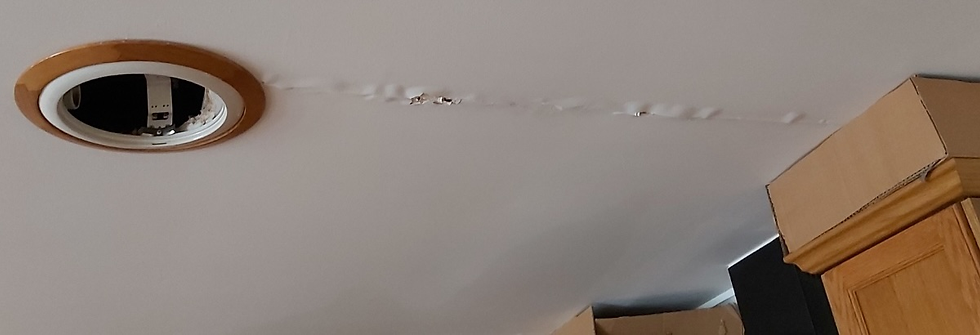Common Drywall Defects and Their Causes
- tedpyzyk
- Feb 11
- 3 min read
Drywall is a staple in modern construction, offering a smooth, affordable, and durable surface for walls and ceilings. However, despite its many advantages, drywall can develop various defects over time due to installation errors, environmental factors, or structural issues. Here are some of the most common drywall defects and their causes.
1. Nail and Screw Pops
Description: Small circular bulges or protrusions appear on the drywall surface. Causes:
Improper fastening of screws or nails
Wood framing movement due to temperature and humidity changes
Using incorrect fastener length or spacing

A screw pop can be almost imperceptible on a textured ceiling.
2. Cracks in Drywall
Description: Hairline or larger cracks appearing on walls or ceilings.
Causes:
House settling or foundation movement
Poorly taped joints
Excessive moisture or extreme temperature changes
Improper installation, such as inadequate use of drywall compound

Hairline drywall crack on textured wall. Cracks are common around windows and door frames.
3. Joint Taping Issues
Description: Visible or peeling drywall tape along joints.
Causes:
Insufficient joint compound application
Using low-quality or improper tape
Moisture intrusion behind walls
Failure to allow compound layers to dry properly

Delaminated drywall tape that has been removed. The paint also showed poor adhesion likely due to failure to prime and/or a dirty surface. 
Delaminating tape due to insufficient joint compound. Corners are also a common area for hairline cracks.
4. Sagging or Bulging Drywall
Description: Sections of drywall appear to droop or bulge outward.
Causes:
Improper installation with insufficient fastening
Over-spanned ceiling joists or improper framing
Exposure to excessive moisture, weakening the drywall
Use of incorrect drywall thickness for ceilings

Sagging drywall ceilings are generally accompanied by cracks
5. Bubbling or Blistering Paint
Description: Raised bubbles under the paint surface.
Causes:
Trapped moisture or water damage
Painting over an unprimed or dirty surface
Incompatible paint layers
Poor-quality paint application

Bubbling paint at joint due to water intrusion
6. Peeling or Flaking Drywall Compound
Description: Drywall mud separating from the surface, creating uneven patches. Causes:
Applying compound in thick, uneven layers
Inadequate surface preparation before application
Using old or expired drywall compound
Exposure to moisture or humidity before drying

Peeling joint compound
7. Water Damage and Stains
Description: Brownish or yellowish stains on the drywall surface, often accompanied by soft spots.
Causes:
Plumbing leaks behind walls
Roof leaks causing water infiltration
High indoor humidity levels leading to condensation
Flooding or prolonged exposure to moisture

Water damage from a leaking toilet. Drywall damage is often the first sign of a plumbing problem.
8. Texture Mismatches
Description: Inconsistent or uneven textures on the drywall surface.
Causes:
Poor technique when applying texture
Using different batches of texture material
Attempting to repair without blending the texture properly
Incorrect drying time before painting

Texture-matching is often the most difficult part of a repair. Here in SE WI, orange peel, knock-down, and sand texture are the most common.
9. Mold Growth on Drywall
Description: Dark spots or patches, often accompanied by a musty odor.
Causes:
High humidity or excessive moisture
Poor ventilation in rooms like bathrooms and basements
Leaks from plumbing or roofing
Organic material in drywall providing food for mold growth

When mold is present, it is often found on the backside of the board due to less ventilation in the wall cavity.
Preventing Drywall Defects
While drywall defects can be frustrating, many can be prevented by following proper installation techniques and using high-quality materials. Here are some key prevention tips:
Ensure proper framing and secure fastening of drywall sheets.
Use high-quality joint compound and tape for seamless joints.
Maintain a controlled environment to minimize moisture exposure.
Prime and prepare surfaces before painting.
Regularly inspect for leaks or moisture issues to prevent water damage.
If you're experiencing drywall issues, professional repair services can help restore your walls and ceilings to their best condition. Addressing problems early can prevent further damage and maintain the integrity of your home or business space.
Have drywall problems? We can help!
Submit a request or give us a call: 262-235-0639

Comments